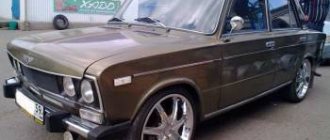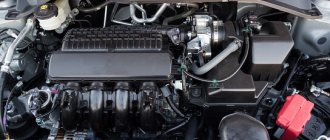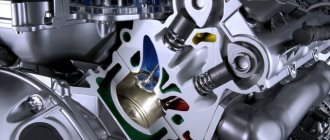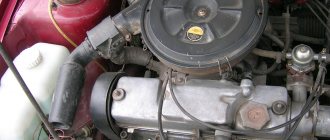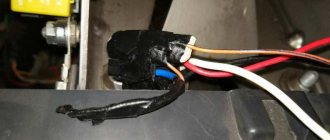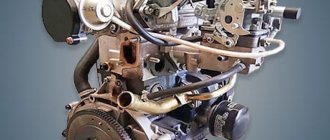When cold the car starts with half a turn. When it's hot (I arrived, turned it off and started it within a few minutes) - also with half a turn. It's worth standing for about 15 minutes. - and when starting, turn the starter
20-40sec. Until he grabs it. — I scoured the Internet and couldn’t find anything sensible. Many attribute this feature to carburetor VAZs, and those who disagree, then sin on: - carburetor - was at the tuner's today, - everything is in order - fuel pump overheating - tried the "old-fashioned" method with a wet rag - nothing has changed. (and I don’t really believe that this is the problem) and then these same people write back a little later that the problem has returned... I also noted for myself that some people do not encounter this problem at all. So what is it? Because of which? “To put up with it and get used to it is the last thing.” Moreover, I remember well that I have my old VAZ 2106, it started with half a turn in any situation. And the fuel pump in it overheated only once - in the summer on a long climb. The car just stalled. And then it turns out that there is no heat yet, but it is already overheating? And then only if you turn off the car. And if you leave it running at idle, then nothing will overheat? — that’s how it doesn’t fit with me...
— Looking on the Internet at photographs of the engine compartment of VAZ classics and chisels (in the hope of understanding the reason and finding the difference), a thought crept into my mind: what if the problem is the length of the fuel line in the area between the pump and the carburetor?
Causes and malfunctions and how to fix them
Lack of fuel in the carburetor
- There may be problems with the fuel supply to the carburetor. We check the fuel supply system (before entering the carburetor) by removing the hose from the fuel supply fitting on the carburetor and pressing the pump lever on the fuel pump several times. A strong, pulsating stream of fuel should come out of the hose opening. If the stream is weak or not at all, then the fuel pump or some other element of the power system may be faulty. As a result, the fuel supply is insufficient or stops altogether.
The strainer at the carburetor inlet is clogged
- We take out the mesh filter by unscrewing its plug, rinse it, clean it with a brush (you can use a toothbrush), blow it out and put it back. At the same time, we clean the seat under the filter in the carburetor cover.
The EPH valve or system has failed
- With the engine off, turn on the ignition and try removing and installing the wire end from the valve outlet. A click should be heard. If it is not there, we connect a piece of wire plus the battery and the valve outlet. There is no click - we change the valve. A click appears - we are checking the EPH system. In addition, it is worth checking the presence and integrity of the rubber O-ring on the valve.
- On carburetors with an idle fuel jet holder, unscrew the holder and remove the jet from it. Clean, rinse and blow with compressed air. We put it back.
“Suction” of foreign air into the carburetor
- Inspect the tubes and hoses leading to the carburetor. Perhaps they have come off the fittings or are damaged. As an example, carburetor 2108-1107010 and hoses leading to it.
The fuel or air jets of the main carburetor metering system are clogged
- In this case, the fuel mixture will be lean. On 2105-07 carburetors, it is necessary to remove the carburetor cover, unscrew the fuel nozzle of the first chamber, and clean it with a thin wooden stick or copper wire. Then blow it out with compressed air and screw it back in. At the same time, it is worth cleaning the remaining elements of the main carburetor metering systems (shown in the photo). On carburetors 2108-21083, we also remove the cover and unscrew the air jet of the first chamber. We take out the jet along with the emulsion tube. Using a slotted screwdriver, unscrew the fuel nozzle located at the bottom of the emulsion well. We wash, clean, blow through it and at the same time the emulsion tube and the emulsion well.
Carburetor needle valve not sealing
- The carburetor overflows, the spark plugs are wet after starting. Replace the worn unit, as even the slightest fuel leak can lead to serious problems. Visually, there may be streaks of gasoline on the carburetor and a persistent smell. Remove the carburetor cover and check whether the float bracket is stuck on its axis, whether the float is touching the walls of the float chamber, or whether the needle valve body is loose. You can try to start the engine if, when starting, you turn it for a long time with the starter while pressing the gas pedal all the way. In this case, due to increased ventilation of the combustion chambers, the spark plugs will dry out and the fuel mixture will normalize. To begin with, you can check the tightness of the needle valve of the float chamber.
The fuel level adjustment in the carburetor float chamber is broken
In this case, the mixture again becomes overrich due to an increase in the fuel level in the float chamber. Adjust it.
Before searching for the reasons that a hot carburetor engine does not start, it is recommended to check the serviceability of the ignition system, since the symptoms of its malfunction are similar to the symptoms of a malfunction of the ignition system.
If you find an error, please select a piece of text and press Ctrl+Enter.
Take care in advance
In general, in cold weather, the alarm system’s already weakened battery is additionally drained. If the car is stored in a guarded parking lot, it is better to leave it unguarded, thereby increasing the chances of starting in the morning. In order to open the doors without problems, you need to keep a can of a composition called “lock defroster” in your clothing pocket all winter. It costs a penny, but it helps a lot when the key refuses to even “go” into the hole. If you don’t have a defroster at hand, you’ll have to test the old-fashioned method for yourself - warm the key with a lighter.
By the way, if you inject the same defroster or WD-40 into the lock in advance of frost, practically no water gets there. Do not use brake fluid to dissolve ice or treat locks. The lock may open, but by the evening it will freeze again, because, unlike special fluids, the brake fluid does not repel water, displacing it from the lock. In addition, it easily damages car paint.
Also, in severe frosts at night you can go out to warm the engine. Or pay parking attendants to warm up your car overnight. If possible, place it in the garage. Even in an unheated room, the temperature is 5-7 degrees higher than outside. And these are “two big differences” – minus 27 or minus 20.
If you still can’t start, and you have enough time, then you can try to determine the composition of the fuel mixture. To do this, simply remove one of the spark plugs from the engine and inspect it. If there are black (or very dark) deposits, the fuel mixture is quite rich, which means that there is something wrong with the car’s ignition system. Most often, in such cases, it is enough to replace the spark plugs, and engine starting returns to normal.
If there is no dark carbon deposit on the removed spark plug or it is white, we are talking about a lean fuel mixture. In this case, the culprit of the problem is often the coolant temperature sensor. You will always have problems with this - you will have to replace it.
When the fuel mixture is lean, some car owners try to start the engine using various additives that increase the octane number of the fuel. Sometimes they succeed. Another method that is often used in this situation is the injection of ether compounds to start carburetor engines. However, dealing with depressurization of the intake tract in the cold, and then doing all this in the reverse order, is not a pleasant task.
Another reason for a lean fuel mixture can be insufficient fuel pressure in the system. There are mainly two reasons here. This is either a dying fuel pump or a fuel pressure regulator. If there is a problem with the fuel pump, it may be impossible to start the engine. But sometimes the fuel pressure in the system can be raised to optimal if you plug the drain hose by squeezing it
This must be done carefully, as it may burst in severe frost. After starting the engine, do not continue to pinch the hose.
Otherwise, there is a high probability that the spark plugs will be splashed with too rich a fuel mixture. If this happens and the engine stalls, allow the mixture to evaporate by waiting 5-10 minutes. Or clean the spark plugs.
The most common cause of problems starting a cold engine can be the usual depressurization of the intake tract. Most often we are talking about a slipped (sometimes burst) tube that connects the fuel pressure regulator in the system to the intake manifold. Carefully inspect the connections of all tubes (hoses, etc.) that go from the intake tract to other systems or elements (brake system, adsorber, crankcase ventilation, etc.), and if there are serviceable elements of the injection system, problems with cold starting on your car will not.
Tips for starting the engine in cold weather:
- Keep the tank full - this will prevent condensation from forming and water will not get into the fuel.
- Turning on the high beams for a couple of seconds before starting will restore some of the battery capacity on frosty days.
- After turning the key in the ignition switch (on an injection car), wait a few seconds until normal pressure is created in the fuel system, and only then start the engine.
- Pump up gasoline manually (on a carburetor car), but you must not overdo it, otherwise the spark plugs will flood.
- Cars run on gas, under no circumstances should you start them cold, switch to gasoline first!
Why the VAZ-2106 does not start and what to do
Cars from the Togliatti Automobile Plant are simply extremely popular among domestic consumers.
However, the main reasons for the demand for them can only be said to be the relatively low price and availability of spare parts. Otherwise, these vehicles are much inferior to imported cars. Quite often, owners of domestic cars are faced with the fact that the VAZ-2106 does not start. What is the reason for this problem, and what to do if it has happened to you? In this article we will provide answers to these questions, and also give a number of useful tips for repairing the “six”.
The starter rotates, but there are no flashes
The next typical malfunction is the rotation of the starter in the complete absence of flashes. Here are the reasons why this could happen:
- broken timing belt. The first thing the owner of a VAZ 2106 should do when noticing the rotation of the starter without flashes is to check the integrity of the timing belt. It's simple: the starter rotates properly, but the torque is not transmitted to the crankshaft, since there is simply nothing to transmit it to, since the timing belt has broken (or has flown off the guides - this also happens if the belt is heavily worn and begins to sag). The solution is obvious: the timing belt will have to be changed;
Checking the performance of the power system
If your car won't start, we suggest starting with diagnosing the power system. It is quite possible to do it yourself. This requires:
- open the air filter;
- pour about 10 milligrams of gasoline directly into the carburetor;
- turn the ignition key. If the car starts and immediately stalls, it means that there is a serious problem in the fuel supply to the power unit;
- remove the clamp that tightens the hose connected to the carburetor;
- lower the other end of the hose into a container. Best of all - in a transparent bottle;
- press the fuel pump lever to see if fuel is supplied to the carburetor. If the result is negative, we repair the power system.
Most often, in this very system, the fuel pump fails, which is very sensitive to low-quality fuel. Special filters provide its protection, but over time, the filter elements become clogged and substances enter the pump that negatively affect its operation.
If this is the case, you will need to dismantle the device, thoroughly clean it, install new filters, and only then carry out installation.
Another problem with the fuel pump is air getting into it. To eliminate this problem, you need to very carefully check the entire line, and then eliminate any leaks found.
Poor starting of the VAZ 2107 engine in the cold season
Almost all the problems with the VAZ 2106 engine listed above are typical for the warm season. Poor starting of the “six” engine in winter should be discussed separately. The main reason for this phenomenon is obvious: frost. Due to the low temperature, the engine oil thickens, as a result, the starter simply cannot crank the crankshaft at a high enough speed. In addition, the oil in the gearbox also thickens. Yes, when the engine starts, the car is usually in neutral gear. But on it, the shafts in the gearbox are also rotated by the engine. And if the oil thickens, these shafts create a load on the starter. To prevent this from happening, you need to fully depress the clutch when the engine starts. Even if the car is in neutral gear. This will take the load off the starter and speed up the start of a cold engine. There are a number of other typical problems due to which the engine cannot start in cold weather. Let's list them:
- poor compression in the engine. This problem is very often observed in old “sixes” with high mileage: compression in the cylinders in the cold becomes very low. Not only can compression be low, but it can also be different. For example, in two cylinders it is normal, in the other two it is low. If the driver has found out that the reason for poor engine starting is low compression, and the car needs to be started urgently, then you should unscrew all the spark plugs and add a little engine oil to the combustion chambers (it is better to do this using a syringe - five “cubes” of oil in each cylinder will be sufficient). After this, you should crank the starter of the car several times without screwing in the spark plugs. The spark plugs are then screwed into place and the engine starts as the engine oil significantly increases compression in the cylinders (albeit only briefly). And to completely eliminate the problem, a major overhaul of the engine should be carried out. And in particular - replacing the piston rings. Without this, normal compression in the cylinders cannot be restored.
There is another way to start a hopelessly frozen car: use the so-called starting fluid. It is sold in auto parts stores. It is injected directly into the carburetor (to do this, you will have to unscrew the air filter cover). And if you don’t want to tinker with the filter cover in the cold, you can unscrew the spark plugs and inject liquid into the combustion chambers. This is also an option, although not as effective;
Problems with the fuel line and carburetor
At the next stage, you need to check the fuel line very carefully - it is quite possible that it is damaged, which is why fuel simply does not flow into the engine.
If no damage has been identified, move on to the carburetor. This device ensures the ignition of gasoline and is also responsible for its enrichment. Dismantling a carburetor is a rather complicated procedure, which is best left to experienced professionals. But if you have repaired your car several times, you can do everything yourself. After disassembly, troubleshooting of device parts is carried out, replacement of worn or failed components, as well as installation and adjustment of the carburetor.
Problems with the carburetor also explain the difficulties with starting the engine when hot. The thing is that the needle of this device can move from the required level. This will lead to over-enrichment of the fuel. Symptoms of this breakdown are a constantly disappearing spark, as well as operation of the power unit at low speeds immediately after start-up.
Interior trunk release button
I don’t recommend doing magic with opening the block and taking out the contact, it’s very small, and attaching something to it would be a perversion, then it might not fit back in. I didn’t fit it. We take the plastic wall from how to open the trunk on the side of a Chevrolet Cruze, and make a hole with a 22mm drill, I didn’t have one like that, I perverted it with an 8mm drill.
In order to avoid a situation where the cover opens spontaneously, it is recommended to cut the wires leading to the button located near the license plate illumination lamps. In order to install the trunk control key from inside the cabin, you must follow the instructions below.
Check the length of the wire of the purchased button. It is recommended that the key on a Chevrolet Cruze open the trunk at least 2 meters of wiring. Key to be installed Disassemble the center console. This action should be performed carefully so as not to damage the plastic.
In order to remove the button from the housing, you need to cut off the sealant along the contour and squeeze the mechanism itself out of the seat.
Opening the trunk of a Chevrolet Cruze
Selecting a replacement part is not difficult: a laser pointer or an unnecessary portable FM receiver can be used as a donor. In stores of radio components and electronic components you can find a specialized waterproof version of suitable dimensions.
Also, such parts are widely presented on various trading platforms on the Internet. The new button is soldered to the corresponding contacts, placed on glue, after which the case is assembled and insulated with sealant.
If the skills to handle a soldering iron yourself are insufficient, similar work can be done at any point for repairing cell phones and household appliances for a couple of hundred rubles.
After repair, the Chevrolet Cruze trunk release button is checked for functionality and installed back on the car.
How to open the trunk on a Chevrolet Cruze trunk opening button in the cabin For some reason, the manufacturer did not implement the function of opening the trunk from the driver’s seat on the Chevrolet Cruze, which causes some confusion among car owners.
If you have carpets with a pile in your cabin, it makes sense to put the same in the trunk, but be prepared for the fact that you will have to wash it often and remove stains with special chemicals. This is the most popular type because it is inexpensive. The rubber is not susceptible to moisture and is resistant to technical fluids.
This rug is easy to change and clean. The disadvantage of rubber is that in the cold it becomes brittle and hard.
How to open a Chevrolet Cruze without a key
The most expensive material for making car mats. It is easy and quick to clean, does not allow water to pass through, and is light weight. Unlike rubber, polyurethane is temperature resistant; it does not melt in the heat and does not turn to stone in the cold.
Not a very practical material, as scratches and chips appear on it during use. Dismantling the ceiling exposed us to a pristine roof, which was treated at the factory with four pieces of falling off vibration insulation.
Laughter and... We tear off the “vibration” and degrease the roof. The complete covering of the roof with SGM M3 vibration insulation, 3 millimeters thick, simultaneously strengthens the roof metal.
Now it will be much more difficult to push through. We place the vibration-proofing material warm, because this way it will roll out better and start working.
How to open Niva Chevrolet?
The Niva Chevrolet is very popular because it boasts a great combination of value and quality. The model became famous for its high terrain, moderate appetite and beautiful appearance.
Characteristics of the trunk of the Chevrolet Cruze sedan: what to do if it does not open
On the right side there is factory sealant between these parts, but on the left there is none and as a result. The roof sound insulation layer is made by Splen. Then comes the careful assembly of the roof without snags or stains.
Other reasons why the VAZ-2106 does not start
Quite often, the car does not want to start immediately after major or routine repairs. Basically, this problem is caused by poor ignition timing adjustment. You can eliminate it in the following way:
- set the piston of the first cylinder to the highest point of the end of the compression stroke;
- unscrew the candle, close the hole for its installation with a plug made of fabric;
- crank the car's crankshaft;
- After the plug is pushed out of the hole, we fix this position.
In addition, after repairing the car, it is necessary to correctly set the valve timing, for which all indicators are set according to the marks applied at the factory.
Summary
There are seasonal problems with engine operation. For example, in summer the car does not start because the mixture is too rich, in winter – because it is too lean. In order for the car to work properly and so that the owner does not rack his brain with the question “why does the VAZ 2106 not start”, it is necessary to constantly monitor the proper operation of the carburetor and other important components. Then this classic AvtoVAZ model will delight its owner with stable and impeccable performance.
So, we found out for what reasons the VAZ 2106 car may not start. As you can see, all breakdowns can be fixed with your own hands.
VAZ 2106 does not start well when hot
Unread message by Andreys » Tue Jan 26, 2010 6:48:05 AM
Unread message Buiny » Tue Jan 26, 2010 6:49:02 AM
Unread message vit84 » Tue Jan 26, 2010 7:31:56 AM
Yes, it’s normal, I was already thinking maybe, I’m stupid about the carb, I specially went to the city to see a carburetor (trusted) and watched how he does everything exactly the same as me and it doesn’t matter. such a pest.
Added after 1 minute 38 seconds:
no, when you press the throttle it “flows”
Added after 1 minute 18 seconds:
Yes, I tried that too, sometimes it helps, but mostly you drive even longer
Added after 9 minutes 22 seconds:
And I missed one more thing: when you start it hot, it grabs from the first turn (but weakly) and then it starts Zhi-Zhi-Zhi
Added after 29 minutes 54 seconds:
Difficult to start when hot
Unread message mort » Mon May 17, 2010 23:38:21
Re: Hard to start when hot
Unread message Curious » Mon May 17, 2010 23:48:01
Re: Hard to start when hot
Unread message Violent » Tue May 18, 2010 5:51:13 AM
Re: Hard to start when hot
Unread message by Longenen » Tue May 18, 2010 10:51:56 AM
Re: Hard to start when hot
Unread message by Jakson » Tue May 18, 2010 11:27:09
Re: Hard to start when hot
Unread message mort » Tue May 18, 2010 12:10:29 PM
Re: Hard to start when hot
Unread message by Longenen » Tue May 18, 2010 12:16:49
Re: Hard to start when hot
Unread message by Longenen » Tue May 18, 2010 12:19:23
Re: hard to start when hot
Unread message Vazik 07 UA » Wed Jun 09, 2010 10:00:06
Re: hard to start when hot
Unread message byran » Wed Jul 21, 2010 9:22:00 AM
Somehow I didn’t attach any importance, but I’m thinking, let me figure out why when I start it in the morning when it’s not cold (without an air damper), it starts like a tick. But when the car is warmed up, starting is a little difficult, you have to turn the starter for 2-3 seconds. Let's decide something.
Here's what I found: A hot engine does not start or takes a very long time to start.
As a rule, this occurs due to a leak in the fuel valve, but, generally speaking, even with a working carburetor in hot weather, hot starting is difficult (especially in the time range of 15-30 minutes after stopping) due to the fact that the air temperature in the engine compartment rises to 100-110°C (heat stroke). The pressure in the hoses rises, the carburetor float mechanism bleeds fuel into the float chamber and, accordingly, into the engine, causing it to become very rich. source: autocry Who thinks what?
Carburetor car engine starts and stalls
In this article we will take a closer look at the situation when a carburetor engine of a passenger car (VAZ 2108, 2109, 21099, 2105, 2107 and their modifications) starts and stalls due to a carburetor malfunction. Malfunctions of carburetors 2105, 2107 Ozone, 2108, 21081, 21083 Solex and their modifications will be considered.
Symptoms of a problem
— The engine starts, runs for a few seconds and stalls, repeated starts are unsuccessful
— The engine starts with difficulty, after running for a short time it stalls, after restarting it starts and runs
— The engine starts and immediately stalls, restarts and stalls again, and so on several times, but then it still starts working
Causes of the malfunction “carburetor engine starts and stalls”
— There is no fuel in the float chamber
Pump it up using the manual pump lever on the fuel pump.
